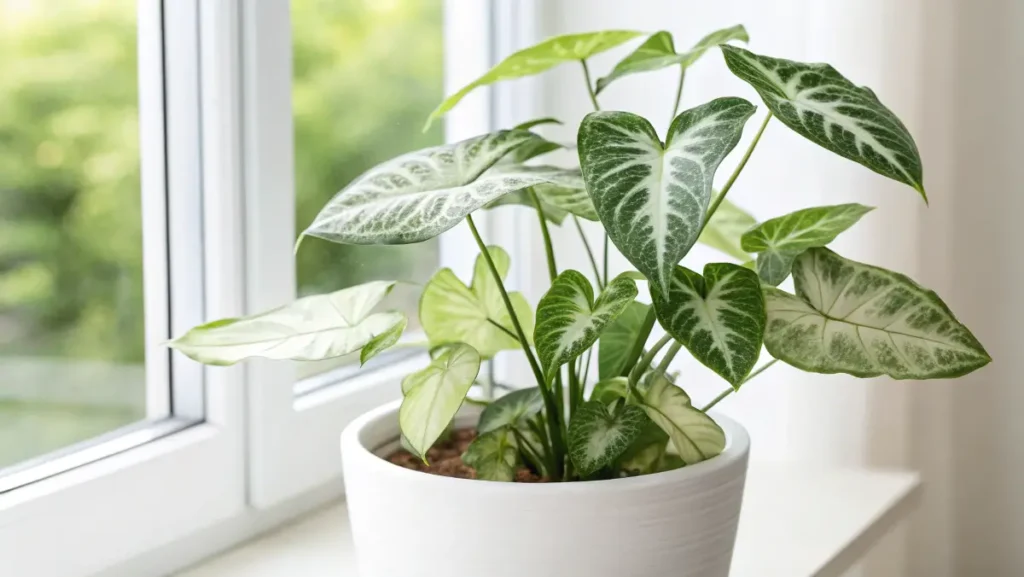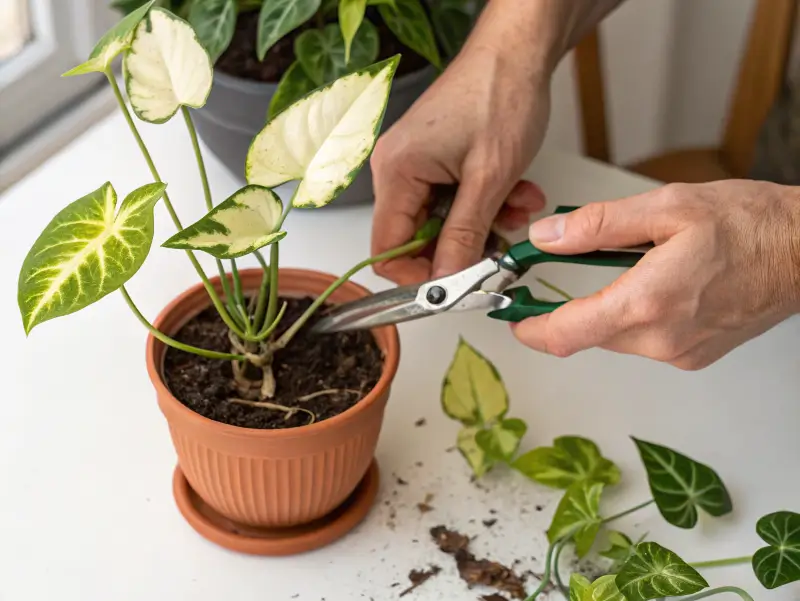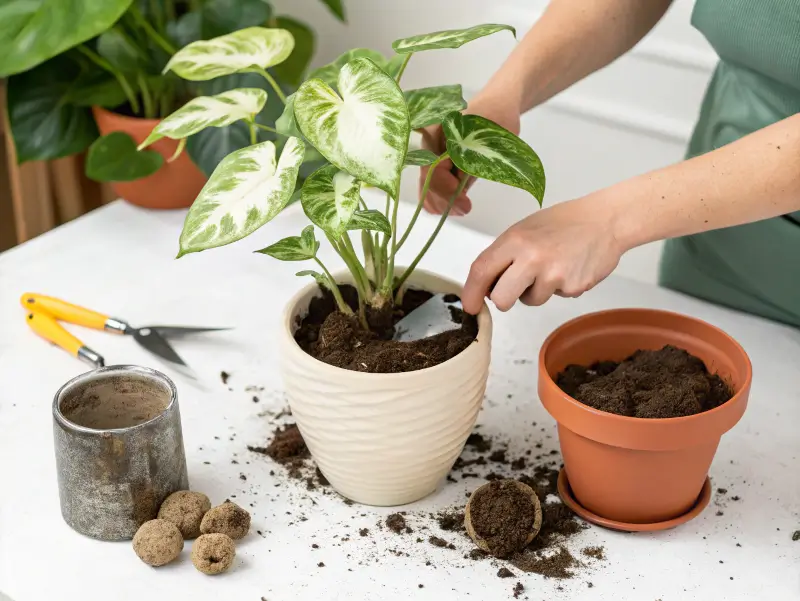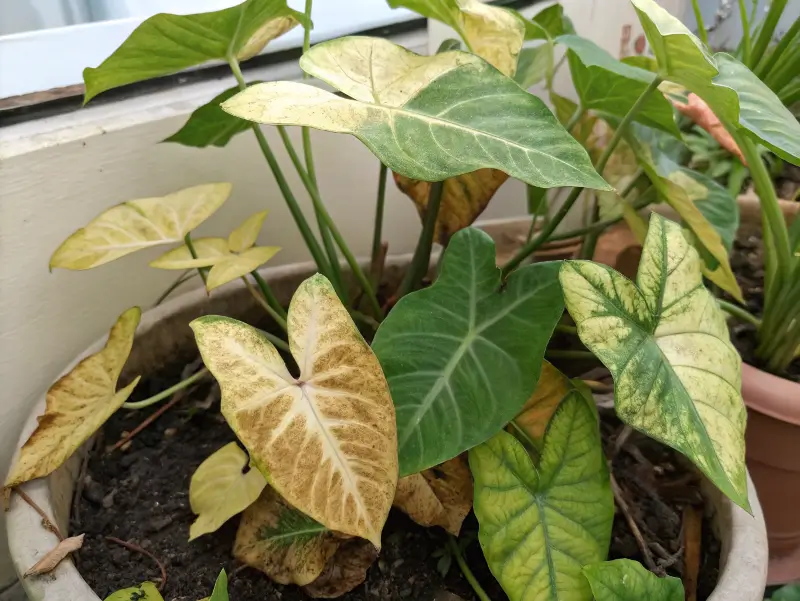
In This Article
Nephthytis plant, or Syngonium podophyllum, is a stunning arrowhead vine beloved for its distinctive arrow-shaped leaves that magically transform into lobed foliage as they mature. This fast-growing beauty reaches 3-6 feet indoors, thriving in bright, indirect light with consistently moist soil. Easy-care and forgiving for beginners, this tropical charmer features gorgeous variegated patterns in white, pink, or cream. Just keep away from pets—it’s toxic if nibbled!
Nephthytis Plant Care Requirements
Light Requirements
Your arrowhead vine loves bright, indirect light near a window but not direct sun rays. I learned this the hard way when my nephthytis plant got awful brown, crispy edges from too much sun. Now I keep it 3-4 feet from an east-facing window, and it’s thriving beautifully.
However, don’t panic if your space isn’t super bright. These plants can actually tolerate lower light conditions, though you might notice the beautiful variegation starting to fade. The leaves will turn more solid green, which isn’t necessarily bad – just different.
Pro tip: If you’re dealing with a darker space, consider rotating your nephthytis plant every few weeks so all sides get equal light exposure.
Watering Guidelines
Watering is where most people either nail it or mess up their nephthytis plant care routine. Find that sweet spot between “desert dry” and “swamp soggy.” Check soil with your finger – when the top inch feels dry, water once or twice weekly in growing season, every 10 days in winter.
Here’s what I’ve learned after killing my fair share of plants: always water thoroughly until you see it draining from the bottom holes. Then wait. Don’t water again until that top layer is dry.
Quick watering tips:
- Use room temperature water
- Filtered or distilled water works best
- Empty the saucer after 30 minutes
- Less is more during winter months
Soil Preferences
Your arrowhead plant isn’t too fussy about soil, but it definitely has preferences. Think well-draining potting mix that still holds some moisture – kind of like a good chocolate cake that’s moist but not soggy. I use standard potting mix with added perlite or bark chips for drainage.
The pH should be slightly acidic, around 5.5-6.5, but honestly, most commercial potting mixes fall into this range naturally. Don’t overthink it unless you’re having specific problems with your nephthytis plant.
Temperature and Humidity
These tropical beauties love warmth and humidity – think of their natural rainforest habitat. Ideally, keep temperatures between 65-80°F, and never let it drop below 60°F.
But here’s where it gets interesting – humidity matters more than most people realize. Your nephthytis plant will be much happier with 40-60% humidity. In dry indoor air, you might notice brown leaf tips or slower growth.
Easy humidity boosters:
- Group plants together
- Use a pebble tray with water
- Run a humidifier nearby
- Mist occasionally (but not daily)
Fertilizer Schedule
During growing season, I feed my arrowhead vine monthly with a balanced liquid fertilizer diluted to half strength. Honestly, these plants aren’t heavy feeders, so don’t go overboard.
In fall and winter, I basically stop fertilizing altogether. The nephthytis plant slows down its growth, so it doesn’t need the extra nutrients. Over-fertilizing during dormant periods can actually cause more harm than good.
Types and Varieties of Nephthytis
Popular Cultivars
Oh my goodness, the variety of nephthytis plant cultivars available now is just incredible! When I started collecting arrowhead plants years ago, you could basically find the standard green and white variety. Now? There are so many gorgeous nephthytis plant options.
‘White Butterfly’ is probably the most common and honestly, still one of my favorites. The classic white and green variegation never gets old, and it’s super easy to find at most garden centers.
‘Pink Allusion’ is absolutely stunning with its pink-tinted foliage. The color is most vibrant in bright light, and it’s definitely a conversation starter when people visit.
‘Neon Robusta’ brings this amazing lime-green color that practically glows. It’s like having a little piece of sunshine in your plant collection.
Then there’s ‘Berry Allusion’ with its purple-pink coloration – it’s probably my current obsession. The colors shift depending on the light and season, which keeps things interesting.
Growth Habits
Something really cool about these plants is how dramatically their leaves change as they mature. Young plants have those perfect arrow-shaped leaves, but as they age and start climbing, the leaves develop deep lobes and can get quite large.
You can actually influence this somewhat by providing support. Give your nephthytis plant a moss pole or trellis, and you’ll see those mature, lobed leaves develop. Keep it in a hanging basket without support, and it’ll maintain more of that juvenile arrow shape.
Pruning Your Nephthytis Plant

When to Prune
Spring and early summer are definitely the best times for major pruning. That’s when your nephthytis plant is actively growing and can bounce back quickly from any cuts.
But honestly, I’m constantly doing little maintenance pruning throughout the year. Dead leaves, yellowing stems, or wayward vines that are getting too long – I just snip them as I notice them.
Signs it’s time to prune:
- Yellowing or brown leaves
- Overgrown, leggy vines
- Loss of bushy appearance
- Dead or damaged stems
Pruning Techniques
Oh my goodness, the variety of nephthytis plant cultivars available now is just incredible! When I started collecting these nephthytis plant varieties years ago, you could basically find the standard green and white variety. Now? There are so many gorgeous nephthytis plant options.
Don’t throw away those healthy cuttings! They’re perfect for propagation, which brings us to our next topic.
Propagating Nephthytis Plant
Stem Cutting Method
Propagating nephthytis plant cuttings is honestly one of the most satisfying things about growing arrowhead vines. It’s so easy, and you end up with new nephthytis plant specimens to share with friends or expand your collection. I take 4-6 inch cuttings with 2-3 nodes – those little bumps where roots develop are crucial for success.
You can root them in water or directly in moist potting mix. I usually start with water because it’s fun to watch the roots develop. Once they’re about 1-2 inches long, I transplant them to soil.
Water propagation steps:
- Cut below a node with clean shears
- Remove lower leaves that would sit underwater
- Place in a clear glass with water
- Change water every few days
- Wait 2-4 weeks for roots to develop
Division Method
If your nephthytis plant has gotten large and bushy, you can actually divide it during repotting. Gently separate the root ball into sections, making sure each piece has both roots and shoots.
This method gives you instant mature plants rather than starting from cuttings. I’ve had great success with this, especially with older, well-established plants.
Success Tips
Timing matters – spring and summer propagation is much more successful than winter attempts. The warmer temperatures and longer days really help with root development.
Keep your propagation setup in bright, indirect light and maintain consistent moisture. Not soggy, but don’t let things dry out completely either.
Be patient! Some cuttings root quickly, others take their sweet time. I’ve had some take up to 6 weeks, so don’t give up too early.
Potting and Repotting Guidelines

Container Selection
For hanging varieties, obviously you’ll want a hanging basket. But if you’re growing your nephthytis plant as a climber, consider getting a pot that’s wide enough to accommodate a moss pole or trellis.
Size-wise, only go up one pot size when repotting. Going too big too fast can actually lead to overwatering issues because there’s too much soil holding moisture around the roots.
Repotting Schedule
Most arrowhead plants need repotting every 1-2 years. You’ll know it’s time when you see roots growing out of the drainage holes or the plant becomes top-heavy and tips over easily.
Spring is definitely the best time for repotting. The nephthytis plant is entering its active growing season and can handle the stress better.
I always use fresh potting mix when repotting. Even if the old soil looks fine, it’s probably depleted of nutrients and may have become too compacted.
Repotting Process
Gently remove the plant from its current pot – sometimes I have to squeeze the sides or tap the bottom to loosen stubborn root balls. Don’t pull on the stems!
Trim any black, mushy, or overly long roots with clean scissors. Healthy roots should be white or light-colored and firm to the touch.
Place some fresh potting mix in the new container, position your nephthytis plant, and fill in around the sides. Water thoroughly after repotting and keep in bright, indirect light while it settles in.
Common Pests and Diseases
Frequent Pests
Let’s face it – even the healthiest plants sometimes get unwanted visitors. The most common culprits on arrowhead plants are spider mites, aphids, mealybugs, and scale insects.
Spider mites are probably the most annoying because they’re so tiny you barely notice them until there’s webbing everywhere. They love dry conditions, so maintaining good humidity helps prevent them on your nephthytis plant.
Aphids usually show up as tiny green or black bugs clustered on new growth. They leave behind sticky honeydew that can attract other problems.
Mealybugs look like little cotton balls stuck to your plant. They’re actually quite easy to spot, which is good because they can multiply quickly if left unchecked.
Treatment options:
- Insecticidal soap spray
- Neem oil applications
- Rubbing alcohol on cotton swabs for spot treatment
- Increasing humidity to discourage mites
Disease Issues
Root rot is by far the biggest disease threat, and it’s almost always caused by overwatering or poor drainage. The roots turn black and mushy, and the nephthytis plant starts declining rapidly.
Bacterial leaf spot can occur in overly humid conditions with poor air circulation. You’ll see water-soaked spots on the leaves that eventually turn brown.
Prevention is always better than treatment, so focus on proper watering, good drainage, and adequate air circulation around your plants.
Common Issues and Solutions
Yellowing Leaves

This is probably the most common question I get about nephthytis plant care. Yellow leaves can mean several different things, which is why it’s frustrating for new plant parents.
Overwatering is the most common cause – those lower leaves turn yellow first as the roots struggle in soggy soil. But underwatering can also cause yellowing, usually starting with older leaves.
Sometimes it’s just natural aging. Older leaves will yellow and drop as the nephthytis plant puts energy into new growth. This is totally normal and not a cause for concern.
Quick diagnostic:
- Check soil moisture first
- Look at which leaves are affected
- Consider recent changes in care or environment
- Examine roots if other symptoms are present
Loss of Variegation
This one breaks my heart every time I see it! Those beautiful white, pink, or cream patterns start fading, and you’re left with mostly green leaves.
Insufficient light is usually the culprit. Variegated plants need more light than their solid-colored cousins to maintain those gorgeous patterns. Much like how colorful foliage plants such as Croton Mammy require bright conditions to maintain their vibrant colors.
Moving your nephthytis plant to a brighter location often helps, but it can take months to see improvement in new growth. The already-faded leaves won’t regain their variegation.
Drooping or Wilting
When your normally perky arrowhead vine starts looking sad and droopy, it’s usually telling you something about water or environmental stress.
Both over and underwatering can cause drooping, which is confusing! Check the soil to determine which direction to go with your watering adjustment.
Temperature shock from cold drafts or sudden changes can also cause wilting. These tropical plants really don’t like sudden environmental changes.
Slow Growth
If your nephthytis plant seems stuck in slow motion, consider light levels first. Low light is the most common reason for sluggish growth in houseplants.
Poor nutrition can also slow things down, especially if you haven’t fertilized in a long time or if the plant has been in the same soil for years.
Being rootbound will also slow growth significantly. If it’s been more than two years since repotting, that might be your answer.
Frequently Asked Questions
How do you take care of a nephthytis plant?
The basics are pretty straightforward: bright, indirect light, consistently moist (not soggy) soil, temperatures between 65-80°F, and monthly fertilizing during the growing season. It’s really about finding that balance and staying consistent with your nephthytis plant care routine.
Does nephthytis like sun or shade?
Neither extreme, actually! These plants prefer bright, indirect light – think of a spot near a window but not in direct sun rays. Too much direct sun will scorch the leaves, while too little light causes loss of variegation and leggy growth.
Is a nephthytis plant poisonous?
Yes, unfortunately it is toxic to both pets and humans if ingested. The nephthytis plant contains calcium oxalate crystals that can cause mouth irritation, difficulty swallowing, and digestive upset. Keep it out of reach of curious pets and small children. If you’re looking for pet-safe alternatives, consider plants like Echeveria Agavoides which are non-toxic succulents.
What is the common name for nephthytis?
Most people call it arrowhead vine or arrowhead plant because of those distinctive arrow-shaped leaves. You might also hear it called goosefoot plant, especially referring to the mature, lobed leaves that resemble a goose’s foot.
Final Thoughts
Growing a nephthytis plant has been such a rewarding journey for me, and I hope this guide helps you succeed with yours too! These plants really are forgiving once you understand their basic needs, and the variety of cultivars available means there’s probably one that’s perfect for your space and style.
Remember, according to the USDA’s indoor air quality research, many houseplants including arrowhead vines can help improve indoor air quality, making them both beautiful and functional additions to your home.
